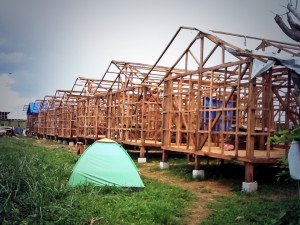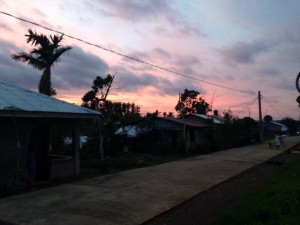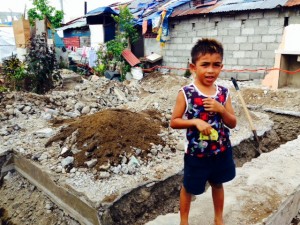Text and photos by Ariel Neidermeier
Bangon Leyte
Since I’ve been in Leyte, I often see the words “Bangon Leyte” featured on signs and scrawled on walls around the island. “Bangon” in tagalog means “rise up.” This phrase seems to be the rallying cry of the rebuilding effort in the Province of Leyte.
Leyte is rebuilding, that much is clear. As you drive through the countryside, you see construction sites underway in all forms: roofs being replaced, the foundations of houses erected. In Ormoc, many of the buildings are damaged but the rebuilding effort is obvious. The feeling of the city is hopeful and strong. The feeling of Tacloban City is very different in comparison.
I have been in a small barangay called Santo Nino since Thursday. “Barangay” is a Filipino native term for village or district. Santo Nino is located in the City of Tacloban which is composed of 138 barangays altogether.
Santo Nino is a 40 minute drive from the urban center of Tacloban City. All Hands  Volunteers has set up a volunteer project in the barangay constructing temporary housing for Filipino families living in some of the most damaged areas of Tacloban City. The families most in need of shelter – those who are still living in tents following the destruction of their homes in the storm – will be moved into the homes on a short term basis until they can create more permanent housing for them. The building site is a project of an NGO called Operation Blessing which has agreed to allow All Hands Volunteers help construct the homes. We have been working alongside Filiipino workers contracted by Operation Blessing. They set the foundations of the houses, we build the walls and floors and they finish them off with roofing.
Volunteers has set up a volunteer project in the barangay constructing temporary housing for Filipino families living in some of the most damaged areas of Tacloban City. The families most in need of shelter – those who are still living in tents following the destruction of their homes in the storm – will be moved into the homes on a short term basis until they can create more permanent housing for them. The building site is a project of an NGO called Operation Blessing which has agreed to allow All Hands Volunteers help construct the homes. We have been working alongside Filiipino workers contracted by Operation Blessing. They set the foundations of the houses, we build the walls and floors and they finish them off with roofing.
It’s the hardest work I’ve ever done in my life. We measure out the dimensions of the houses, saw the correct lengths of wood and nail them to place. Sounds easy but it’s incredibly difficult, especially in a hot and humid climate for eight hours a day, six days a week. The volunteers have Sundays off so groups of us will often venture into nearby Tacloban on Saturday nights for internet access and a hot shower.
Tacloban has suffered incredible damage from Haiyan. Massive buildings lay in rubble; countless power lines and tangled webs of electrical wire are knotted in heaps on the ground. As we drove into the downtown area of the city, we passed a massive ship sitting in the middle of a concrete playground that was washed ashore during the storm. According to the other volunteers there are seven ships that were washed ashore like this during the storm surge. The water was so high and the waves so strong that they pummeled right through buildings, knocking through walls of concrete onto land.
 Relief officials and aid workers have flooded the city following the storm. I met a woman last night who works at the United Nations Refugee Agency who is going around to outlying barangays like Santo Nino and performing CWC (Communications with Communities). The agency is assessing the community’s response in outlying barangays like Santo Nino to moving Filipino families from Tacloban’s urban center into their land. The idea is to eventually move the families who were living in Tacloban’s coastal barangays into inland barangays where their homes won’t be at risk for future damage by storms like Haiyan. Obviously, this will impact the existing communities in these inland barangays. It will also impact the families being moved into inland regions who have previously depended on the sea for their livelihoods and sustenance. According to the woman from the UN, the inland communities are not thrilled about the incoming flood of Filipino families, however, there is a certain understanding that the need to create relocation sites is great. The intricacies of the relocation plans are wide-ranging are complex, to say the least.
Relief officials and aid workers have flooded the city following the storm. I met a woman last night who works at the United Nations Refugee Agency who is going around to outlying barangays like Santo Nino and performing CWC (Communications with Communities). The agency is assessing the community’s response in outlying barangays like Santo Nino to moving Filipino families from Tacloban’s urban center into their land. The idea is to eventually move the families who were living in Tacloban’s coastal barangays into inland barangays where their homes won’t be at risk for future damage by storms like Haiyan. Obviously, this will impact the existing communities in these inland barangays. It will also impact the families being moved into inland regions who have previously depended on the sea for their livelihoods and sustenance. According to the woman from the UN, the inland communities are not thrilled about the incoming flood of Filipino families, however, there is a certain understanding that the need to create relocation sites is great. The intricacies of the relocation plans are wide-ranging are complex, to say the least.
I’ll be stationed in Santo Nino for the foreseeable future. There has been talk of setting up different volunteer projects in Tacloban’s urban center, in “tent city,” a strip of barangays right on the coast of Cancabato Bay where displaced families have set up ramshackle shelters until they are placed in better housing. There are many opportunities to assist the deconstruction and rebuilding efforts in this area.
Thanks for reading. Bangon Leyte.
(Note from editor: This is the latest in a series of blogs from the Philippines of Ariel Neidermeir’s volunteer effort with relief the project following Typhoon Haiyan. The Filipino American from the San Francisco Bay Area arrived March 16 and will remain there for nearly three months and will continue to send us updates. You can follow her at @aneidermeier )

